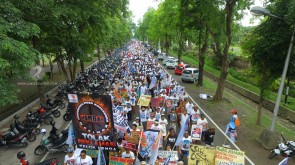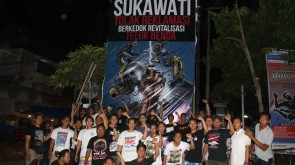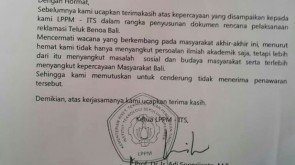Hundreds of activists and residents demonstrated on Tuesday outside the office of Bali’s governor in the island’s capital, rallying against a presidential decree supporting the reclamation of Benoa Bay.
Organized by Bali’s Forum Against Reclamation (ForBali) the protest began with a march from the Bajra Sandhi monument in Renon, Denpasar, and ended at the doorsteps of Governor Made Mangku Pastika’s office.
Demonstrators carried posters and banners calling on the government to “annul 2014 presidential decree no. 51” and pleading, “don’t reclaim Benoa Bay!”
A 2011 decree on the spatial planning of Denpasar, Badung, Gianyar and Tabanan deemed Benoa Bay a conservation area and, therefore, off limits to commercial development.
The governor then backpedaled on the decision by adding an article exempting certain coastal areas — Zone P — from the previously laid out rules, classifying it a public zone and allowing a range of activities, which includes — among others — fishery, tourism, residential development and places of worship.
According to the revision, Benoa Bay now falls under Zone P, changing it from a “water conservation area” to a buffer zone open for forms of exploitation.
Rally coordinator Wayan Gendo Suardana said the revised decree was meant to pave the way for Tirta Wahana Bali International (TWBI), a company owned by Jakarta-based businessman Tomy Winata, to reclaim the bay.
“It has been turned into zone for public purposes. As a consequence, it can be reclaimed,” Gendo said. “The presidential decree was not made to protect the Balinese, but pave the way for investment.
“In the old presidential decree, there was no buffer zone. This [the buffer zone] is merely a way to reduce the conservation area for the interest of capital owners. This is a bad precedent of manipulative spatial planning.
“This is a human rights violation using the law; the state bows down to the interest of capital owners.”
If plans for a reclamation are put into effect, Gendo added, the environmental ramifications could potentially be devastating; erosion, irrevocable damage to mangrove forests and pollution flooding the four rivers that feed into Benoa Bay.
“This project increases the risk of disaster, mainly tsunamis,” he said, adding that ForBali is preparing to file a suit with the Supreme Court to revoke the additional article.
“Our team has been working [on the suit] and we won’t stop until we are successful.”
A decree permitting the Benoa Bay reclamation project was first issued without fanfare on Dec. 26, 2012, but was later revoked by Bali Governor Made Mangku Pastika.
However, the governor later granted TWBI permission to conduct a feasibility study — detailed research analyzing the pros and cons of a proposed business venture — on the area.
The land-use permit issued for this project, meanwhile, makes provisions for a myriad of commercial activities, including yacht marinas, race tracks, casinos, nightclubs, a large entertainment complex and theme park, resort hotels, a golf course, a luxury shopping complex, restaurants and apartment buildings.
Taken from: Jakarta Globe
Hundreds of activists and residents demonstrated on Tuesday outside the office of Bali’s governor in the island’s capital, rallying against a presidential decree supporting the reclamation of Benoa Bay.
Organized by Bali’s Forum Against Reclamation (ForBali) the protest began with a march from the Bajra Sandhi monument in Renon, Denpasar, and ended at the doorsteps of Governor Made Mangku Pastika’s office.
Demonstrators carried posters and banners calling on the government to “annul 2014 presidential decree no. 51” and pleading, “don’t reclaim Benoa Bay!”
A 2011 decree on the spatial planning of Denpasar, Badung, Gianyar and Tabanan deemed Benoa Bay a conservation area and, therefore, off limits to commercial development.
The governor then backpedaled on the decision by adding an article exempting certain coastal areas — Zone P — from the previously laid out rules, classifying it a public zone and allowing a range of activities, which includes — among others — fishery, tourism, residential development and places of worship.
According to the revision, Benoa Bay now falls under Zone P, changing it from a “water conservation area” to a buffer zone open for forms of exploitation.
Rally coordinator Wayan Gendo Suardana said the revised decree was meant to pave the way for Tirta Wahana Bali International (TWBI), a company owned by Jakarta-based businessman Tomy Winata, to reclaim the bay.
“It has been turned into zone for public purposes. As a consequence, it can be reclaimed,” Gendo said. “The presidential decree was not made to protect the Balinese, but pave the way for investment.
“In the old presidential decree, there was no buffer zone. This [the buffer zone] is merely a way to reduce the conservation area for the interest of capital owners. This is a bad precedent of manipulative spatial planning.
“This is a human rights violation using the law; the state bows down to the interest of capital owners.”
If plans for a reclamation are put into effect, Gendo added, the environmental ramifications could potentially be devastating; erosion, irrevocable damage to mangrove forests and pollution flooding the four rivers that feed into Benoa Bay.
“This project increases the risk of disaster, mainly tsunamis,” he said, adding that ForBali is preparing to file a suit with the Supreme Court to revoke the additional article.
“Our team has been working [on the suit] and we won’t stop until we are successful.”
A decree permitting the Benoa Bay reclamation project was first issued without fanfare on Dec. 26, 2012, but was later revoked by Bali Governor Made Mangku Pastika.
However, the governor later granted TWBI permission to conduct a feasibility study — detailed research analyzing the pros and cons of a proposed business venture — on the area.
The land-use permit issued for this project, meanwhile, makes provisions for a myriad of commercial activities, including yacht marinas, race tracks, casinos, nightclubs, a large entertainment complex and theme park, resort hotels, a golf course, a luxury shopping complex, restaurants and apartment buildings.
Taken from: Jakarta Globe










